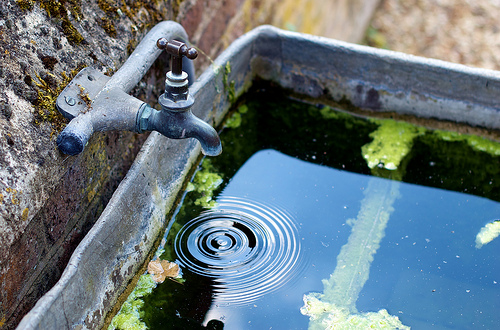Frugal Living – Tips and Hints for Conserving Water
Water is one of our most precious resources. It is also one that is not so easily renewed. Lack of rainfall and low snow pack; the loss of ground water, drying up of reservoirs, polluted streams, rivers and lakes have all made us keenly aware of how difficult our lives could be without water.
But – every day we can do something to reduce the amount of water we use AND recycle the water we must use. Our efforts might seem small, but every drop counts over the course of our life.
At my house water savings starts with bathing. Brianne and I both take five minute baths or showers. A kitchen timer, in the shape of a chicken, sits on the bathroom counter. As soon as the water is turned on the timer is set. It’s amazing how full a tub gets with only 5 minutes worth of water. Try it. I think you’ll be amazed too.
Laundry is another big water user. But, I devised a way to reuse wash water on my trees and shrubs. I took a 33-gallon square trash can and fitted it with a coupling that has a gasket on both sides to prevent leaks. On the outside portion I screwed on a hose fitting that could be turned on and off. To that I hooked up my hose. I then removed the washing machines drain hose from the drain pipe and attached it to the trash can so the water now drains into the trash can and out the bottom through the coupling to the hose. With each load I can move the hose from tree to tree, or shrub to shrub. One caution though – washing machine gray water should not be used where the water may come into direct contact with vegetables or fruits.
Collected rain water can be used to offset water needs in flower beds and garden plots. The system doesn’t have to be sophisticated. A simple barrel or trashcan under a roof line where rain water pours off will work. You’ll be surprised at how quickly the barrel fills. If you have rain gutters, you can set up a more elaborate collection system that can be piped to different areas of your yard. Even barns, chicken coops and other out buildings will produce a good amount of water during the rainy season. Remember – every little bit helps!
Homesteads with livestock use water on a daily basis. It’s important for the animals’ health. When changing or washing out water troughs simply pour it on any plant near by instead of throwing it in the dirt. (last year we watered our entire pumpkin patch just by emptying water troughs on the plants)
Small water saving efforts that have a big impact:
- Keep a pitcher on the kitchen counter to collect ice cubes and leftover drinks, then use on potted plants.
- Place a plastic bowl filled with soapy water in one side of the sink. Use this to wash hands throughout the day. At the end of the day empty the bowl on shrubs or trees. The small amount of soap used will not hurt the plants.
- When brushing your teeth, turn the water off until it’s time to rinse. Then only turn it on low.
- Keep a container of water in the fridge for a cool drink instead of letting the faucet water run until water is cold.
- Check and replace garden hose washers to prevent leakage.
- Do not use running water to thaw meat or other frozen foods. Defrost food overnight in the refrigerator.
- When boiling foods in water, like pasta or potatoes, cool water when finished and use in the yard.
- Kitchen sink disposals use lots of water to operate properly. Start a compost pile as a way of disposing of food waste instead of using a garbage disposal. Garbage disposals also can add 50% to the volume of solids in a septic tank, which can lead to malfunctions and maintenance problems.
- If you are on a well, check your pump periodically. Listen to hear if the pump kicks on and off while water is not being used. If it does, you have a leak.
- Avoid flushing the toilet unnecessarily. Dispose of tissues, insects and other similar waste in the trash rather than the toilet.
- Raise the lawn mower blade to at least three inches or to its highest level. A higher cut encourages grass roots to grow deeper, shades the root system and holds soil moisture better than a closely-clipped lawn. For added water savings, use grass clippings as mulch around plants to help retain soil moisture.
Click here for more ways to conserve water check out “100 Ways to Conserve”,
![]() photo credit: JohnONolan
photo credit: JohnONolan

Recent comments
Aenean nonummy hendrerit mauris. Phasellus porta.